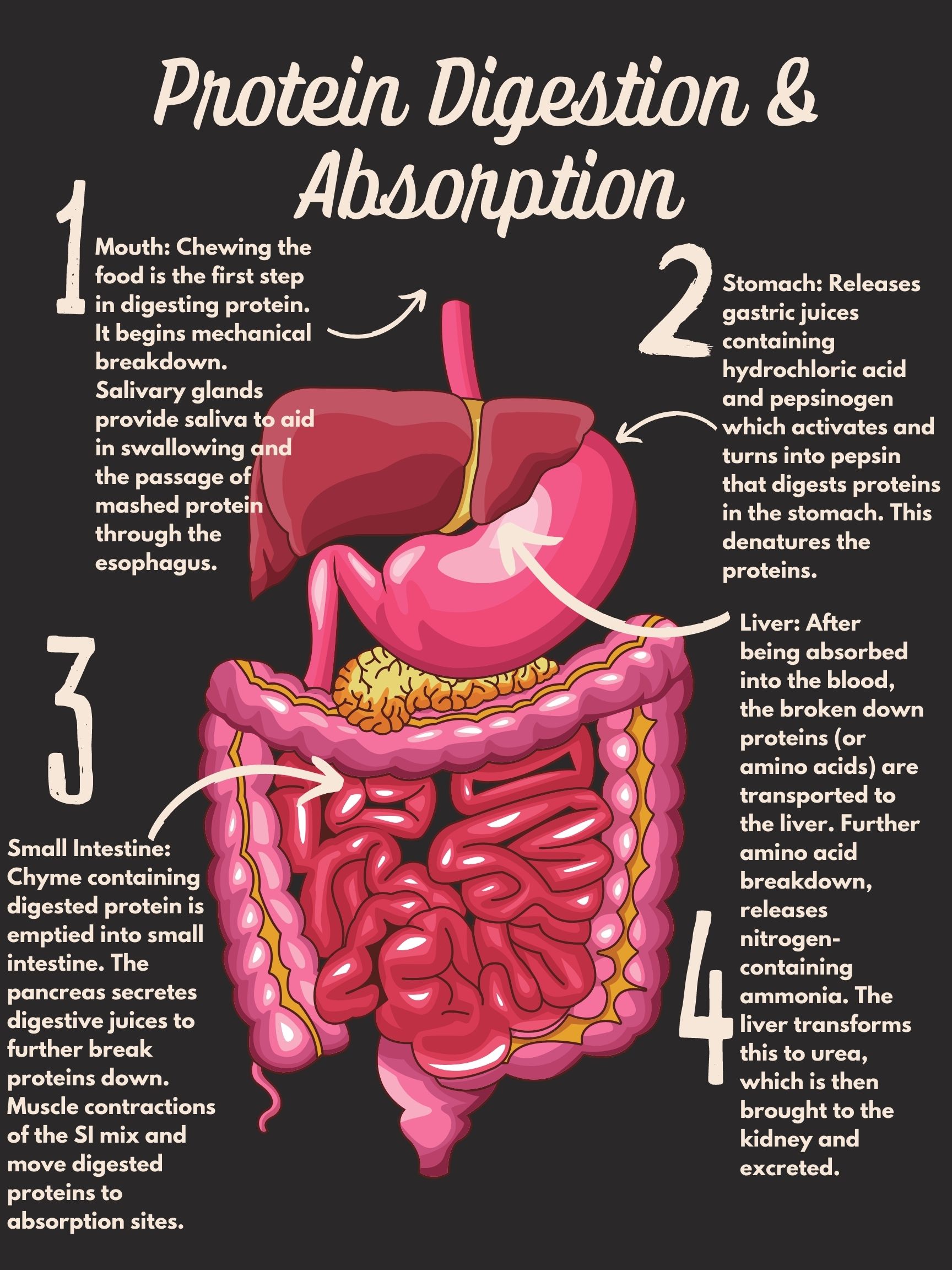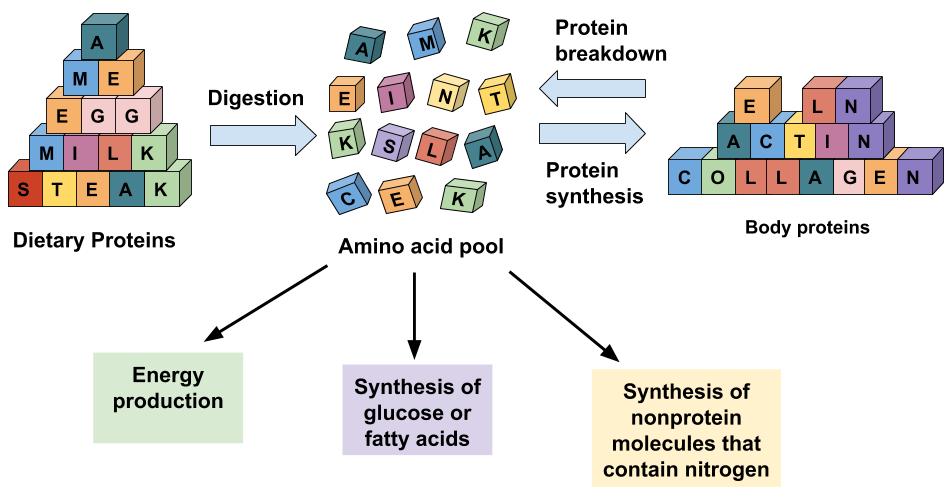7.3 Protein Digestion and Absorption
As you can see, proteins are very complex molecules. Protein in the foods you eat is ingested in quaternary form. The exception to this is certain protein supplements, such as branched chain amino acid (BCAA) supplements that are ingested in amino acid form. Therefore, before your body can use most dietary protein, steps of protein synthesis must be reversed, or the proteins must be denatured. The quaternary structures must be uncoiled and unfolded so the peptide bonds are exposed. Once the peptide bonds are exposed, enzymes can break apart the primary structure and the individual amino acids are absorbed in the small intestine.
Figure 7.6 Protein Digestion Overview

From the Mouth to the Stomach
In most situations, the first step in protein digestion involves chewing. The teeth begin the mechanical breakdown of the large pieces of food into smaller pieces that can be swallowed. The salivary glands provide some saliva to aid swallowing and the passage of the partially mashed protein containing foods through the esophagus. The mashed protein rich foods enter the stomach through the esophageal sphincter. The stomach releases gastric juices containing hydrochloric acid and pepsinogen, the precursor to the enzyme, pepsin. When exposed to hydrochloric acid, pepsinogen activates and turns into pepsin, the major enzyme that digests proteins in the stomach. The acidity of the stomach denatures or facilitates the unfolding of the proteins that still retain part of their three-dimensional structure after cooking and helps break down the protein aggregates formed during cooking. Pepsin dismantles the protein chains into smaller and smaller fragments. The powerful mechanical stomach contractions churn the partially digested protein into a more uniform mixture called chyme. Protein digestion in the stomach takes a longer time than carbohydrate digestion, but a shorter time than fat digestion. Eating a high-protein meal increases the amount of time required to sufficiently break down the meal in the stomach. Food remains in the stomach longer, making you feel full longer.
From the Stomach to the Small Intestine
The stomach empties the chyme containing the partially digested protein into the small intestine. The pancreas secretes digestive juice that contains more enzymes that further break down the protein fragments. The cells that line the small intestine release additional enzymes that finally break apart the smaller protein fragments into the individual amino acids. The muscle contractions of the small intestine mix and propel the digested proteins to the absorption sites. In the lower parts of the small intestine, the amino acids are transported from the intestinal lumen through the intestinal cells to the blood. This movement of individual amino acids requires special transport proteins and the cellular energy molecule, adenosine triphosphate (ATP). Once the amino acids are in the blood, they are transported to the liver. As with other macronutrients, the liver is the checkpoint for amino acid distribution and any further breakdown of amino acids, which is very minimal. Recall that amino acids contain nitrogen, so further breakdown of amino acids releases nitrogen-containing ammonia. Because ammonia is toxic, the liver transforms it into urea, which is then transported to the kidney and excreted in the urine. Urea is a molecule that contains two nitrogens and is highly soluble in water. This makes it a good choice for transporting excess nitrogen out of the body.
Protein Turnover
Just as some plastics can be recycled to make new products, amino acids are recycled to make new proteins. All cells in the body continually break down proteins and build new ones, a process referred to as protein turnover. Every day over 250 grams of protein in your body are dismantled and 250 grams of new protein are built. To form these new proteins, amino acids from food and those from protein destruction are placed into a “pool.” This amino acid pool is not a literal pool. Instead it is the term used to refer to the amino acids circulating in the blood, lymph, and interstitial fluid between cells. When an amino acid is required to build another protein it can be acquired from the amino acids circulating in the amino acid “pool.” Amino acids are used not only to build proteins, but also to build other biological molecules containing nitrogen, such as DNA, RNA, and to some extent to produce energy. It is critical to maintain amino acid levels within this cellular pool by consuming high-quality proteins in the diet, or the amino acids needed for building new proteins will be obtained by increasing protein destruction from other tissues within the body, especially muscle. This amino acid pool is less than one percent of total body-protein content. Thus, the body does not store protein to a significant extent as it does with carbohydrates (as glycogen in the muscles and liver) and lipids (as triglycerides in adipose tissue), therefore protein must be consumed on a regular basis to prevent the breakdown of lean muscle mass.
Figure 7.7 Protein Turnover

Amino acids in the cellular pool come from dietary protein and from the destruction of cellular proteins. The amino acids in this pool need to be replenished because amino acids are outsourced to make new proteins, energy, and other biological molecules.
Media Attributions
- Protein Digestion and Absorption © Natalie Fox is licensed under a CC BY (Attribution) license
- Fates of Protein © Allison Calabrese is licensed under a CC BY (Attribution) license
